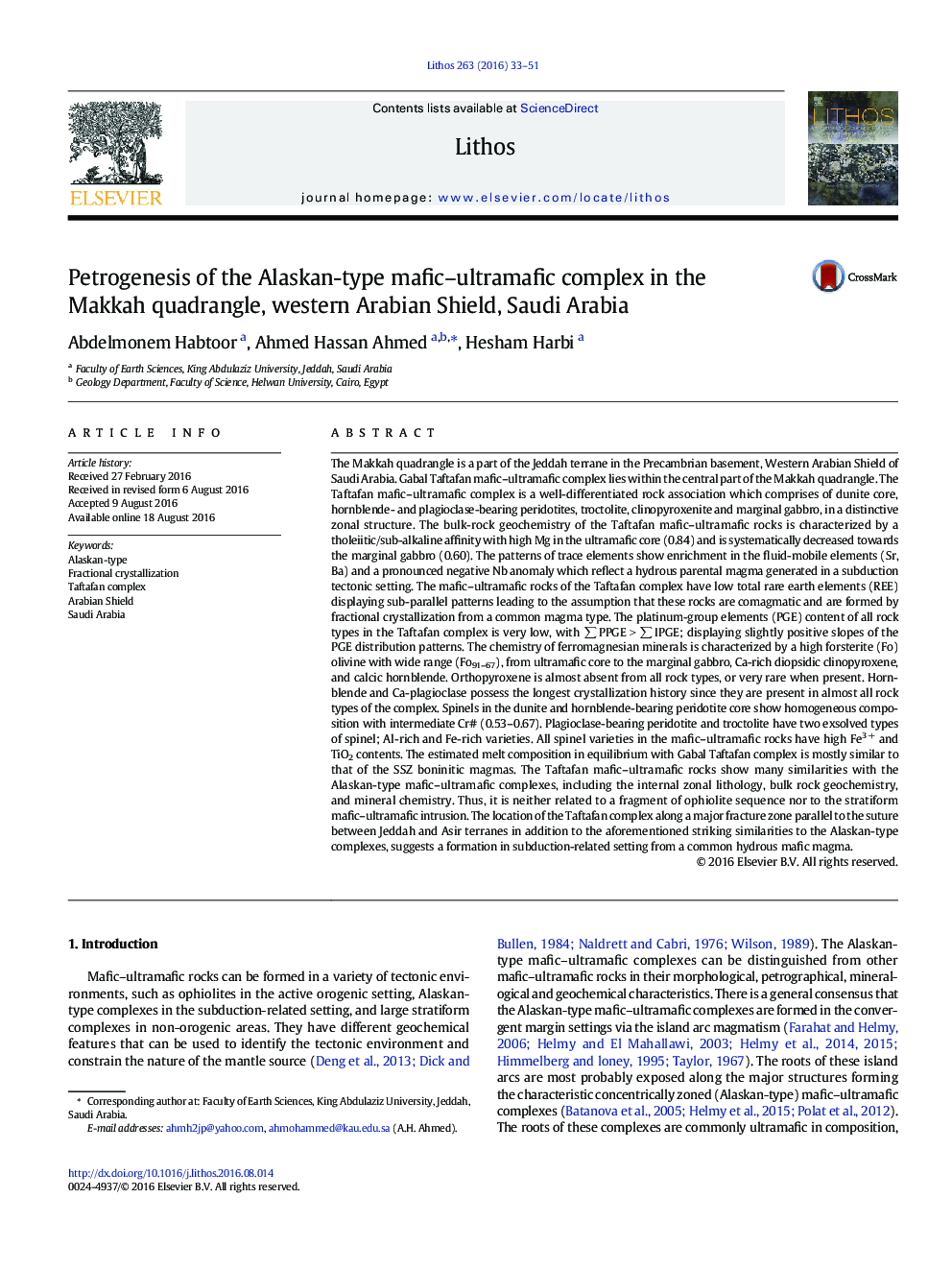| کد مقاله | کد نشریه | سال انتشار | مقاله انگلیسی | نسخه تمام متن |
|---|---|---|---|---|
| 4715466 | 1638641 | 2016 | 19 صفحه PDF | دانلود رایگان |
• First detailed study of Alaskan-type complex in the Arabian Shield, Saudi Arabia
• Taftafan complex is a part of Precambrian basement, western Arabian Shield.
• Characterized by tholeiitic/sub-alkaline affinity of subduction-related setting
• Parallel REE trends indicating co-magmatic origin by fractional crystallization
• Typical Alaskan-type features formed from hydrous mafic magma in arc setting
The Makkah quadrangle is a part of the Jeddah terrane in the Precambrian basement, Western Arabian Shield of Saudi Arabia. Gabal Taftafan mafic–ultramafic complex lies within the central part of the Makkah quadrangle. The Taftafan mafic–ultramafic complex is a well-differentiated rock association which comprises of dunite core, hornblende- and plagioclase-bearing peridotites, troctolite, clinopyroxenite and marginal gabbro, in a distinctive zonal structure. The bulk-rock geochemistry of the Taftafan mafic–ultramafic rocks is characterized by a tholeiitic/sub-alkaline affinity with high Mg in the ultramafic core (0.84) and is systematically decreased towards the marginal gabbro (0.60). The patterns of trace elements show enrichment in the fluid-mobile elements (Sr, Ba) and a pronounced negative Nb anomaly which reflect a hydrous parental magma generated in a subduction tectonic setting. The mafic–ultramafic rocks of the Taftafan complex have low total rare earth elements (REE) displaying sub-parallel patterns leading to the assumption that these rocks are comagmatic and are formed by fractional crystallization from a common magma type. The platinum-group elements (PGE) content of all rock types in the Taftafan complex is very low, with ∑ PPGE > ∑ IPGE; displaying slightly positive slopes of the PGE distribution patterns. The chemistry of ferromagnesian minerals is characterized by a high forsterite (Fo) olivine with wide range (Fo91–67), from ultramafic core to the marginal gabbro, Ca-rich diopsidic clinopyroxene, and calcic hornblende. Orthopyroxene is almost absent from all rock types, or very rare when present. Hornblende and Ca-plagioclase possess the longest crystallization history since they are present in almost all rock types of the complex. Spinels in the dunite and hornblende-bearing peridotite core show homogeneous composition with intermediate Cr# (0.53–0.67). Plagioclase-bearing peridotite and troctolite have two exsolved types of spinel; Al-rich and Fe-rich varieties. All spinel varieties in the mafic–ultramafic rocks have high Fe3 + and TiO2 contents. The estimated melt composition in equilibrium with Gabal Taftafan complex is mostly similar to that of the SSZ boninitic magmas. The Taftafan mafic–ultramafic rocks show many similarities with the Alaskan-type mafic–ultramafic complexes, including the internal zonal lithology, bulk rock geochemistry, and mineral chemistry. Thus, it is neither related to a fragment of ophiolite sequence nor to the stratiform mafic–ultramafic intrusion. The location of the Taftafan complex along a major fracture zone parallel to the suture between Jeddah and Asir terranes in addition to the aforementioned striking similarities to the Alaskan-type complexes, suggests a formation in subduction-related setting from a common hydrous mafic magma.
Journal: Lithos - Volume 263, 15 October 2016, Pages 33–51
